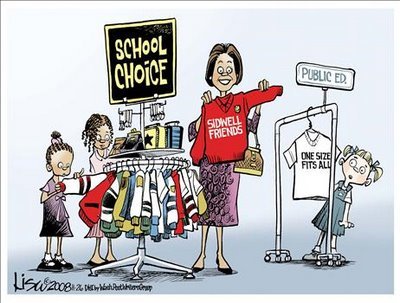This essay is based on remarks delivered on February 23, 2013 at the Eighth Annual Wisconsin Conservative Conference.
In 2016, in time for the next presidential election, every child now in high school will be eligible to vote for the president of the United States. For whom will they vote?
In 2020, when it comes time to reelect or replace that president, every child now in middle school will be eligible to vote. For whom will they vote?
Raising Liberals
New voters won’t vote for conservative candidates if they aren’t being taught real civics. Real civics can be summarized in one sentence: “That all men are created equal, that they are endowed by their Creator with certain unalienable rights, that among these are life, liberty, and the pursuit of happiness.”
How many recent high school or even college graduates know where that sentence comes from or what it means? Very few, I would say. But if they don’t understand it, why would they vote for a candidate who promises to uphold the principles it expresses?
Students also need to be taught real economics: that true wealth is created by free individuals working hard and taking risks. True wealth requires private property rights and free markets, not governments taking by force from one person and giving to another.
We have a president who thinks wealth is created by redistribution, that the producers of the world will continue to produce no matter how high the taxes or how heavy the regulations. High school and college graduates are taught to think the same way. So America’s youth voted for Barack Obama, a man who never created a single job or had to meet a payroll.
The third thing students need to learn is real virtues: honesty, hard work, self-responsibility, faith, hope, and love. Are these things being taught in public schools today? Maybe in some, but not in many.
Here’s my main point: So long as government owns and operates 90 percent of the schools in the United States, we have no right to expect that fewer than 90 percent of students who graduate will be socialists.
America’s History of School Choice
For 200 years, from the 1640s until the 1840s, what we now call K-12 education in the U.S. was almost entirely delivered by private schools, private tutors, and families. The system did involve some public funding – it was not a libertarian fantasy world – but it was primarily organized by freedom, competition, and efficiency.
This system of free-market education was destroyed over the course of two decades starting in the 1850s, the result of an effort led by Horace Mann, the first secretary of the Board of Education of Massachusetts. They started by taking advantage of anti-Catholic bigotry that was widespread at the time: They called for withholding public funding only from Catholic schools.
Once they had succeeding in kicking the Catholics out of K-12 education they campaigned to ban public funding for all religious schools. They placed Blaine amendments in the constitutions of 37 states, including Wisconsin.
Benefitting Adults, Not Kids
The result is the system we see today: Nearly all public money goes to government schools. Government owns the buildings, hires the teachers, dictates the curriculum, writes the tests, and even gets to decide whether or not it’s doing a good job. It sets the standards.
Not surprisingly, this system evolved in ways that benefitted the adults who are employed by the system – administrators and teachers – and not students. Teachers get tenure. Certification requirements erect barriers to entry, and pay becomes based on tenure and degrees rather than classroom performance. Kids are assigned to schools based on where their parents live because that’s easier for the adults to know how many will enroll in a particular school next year.
Control is centralized because that makes it easier for politicians and bureaucrats to enforce the rules on teachers, but it’s not good for kids … or teachers.
One-size-fits-all is easier for bureaucracies, but it’s not good for kids. No two kids learn the same way, and no two teachers teach the same way. Anyone who has kids knows this, and anyone who knows or has watched teachers work knows this. Yet the system sends kids to one-size-fits-all schools and forces teachers to all teach the same thing the same way.
So kids end up in schools that aren’t matched to their needs. Teachers are stuck in schools with philosophies they disagree with, and bureaucracies consume more money than is spent on teachers.
The Return of School Choice
Since the early 1960s, parents and activists have been fighting to return the country’s education system to what had worked so well for 200 years: freedom of choice and competition. Vouchers – basically scholarships that pay some or all of the tuition at schools chosen by parents – restore freedom of choice and competition to education by funding students rather than schools. Government still funds education, but the actual production and delivery of education is in the hands of parents and private schools.
It wasn’t until 1990 that the first modern public voucher program was adopted in Milwaukee. The Milwaukee Parental Choice Program started with only 341 students enrolled in seven private schools. Today, approximately 24,000 students attend 120 schools and the program was just expanded to 11 schools and 500 students in Racine.
The rest of the country has noticed and school choice is now spreading fast. Today there are 29 voucher and tax-credit programs operating in 21 states and Washington, DC. Some 212,000 students are enrolled in private schools thanks to vouchers and tax credits.
Half of the programs were launched since 2006. In 2011–12 13 new programs were started, 14 were expanded, and 42 state legislatures considered legislation. The Friedman Foundation says nationwide, choice programs saved taxpayers $422 million in 2012.
The Future of School Choice
Vouchers clearly work. Independent evaluations show voucher programs produce higher test scores, graduation rates, college enrollment, and parental satisfaction … all at a cost per student that is less than half as much as the government schools spend.
What can’t be measured, but what is even more important, is that what the kids are learning is different. They are learning real civics, real economics, and real virtues. They are graduating equipped to be productive members of society and informed and responsible voters. They will be makers and not takers.
Those graduates are becoming their generation’s opinion leaders. They are natural leaders. They are the future of the freedom movement.
Where do we go from here? States like Wisconsin need to expand school choice statewide: no means-testing, no geographical restrictions. The amount of the voucher needs to be increased, not all the way up to what government schools spend, because half of that is pure waste. But half of what government schools spend would be about right.
If we can return to a free-market education system, we can solve most of our political problems. School choice is the answer to the questions we’re all asking about the future of our country.





